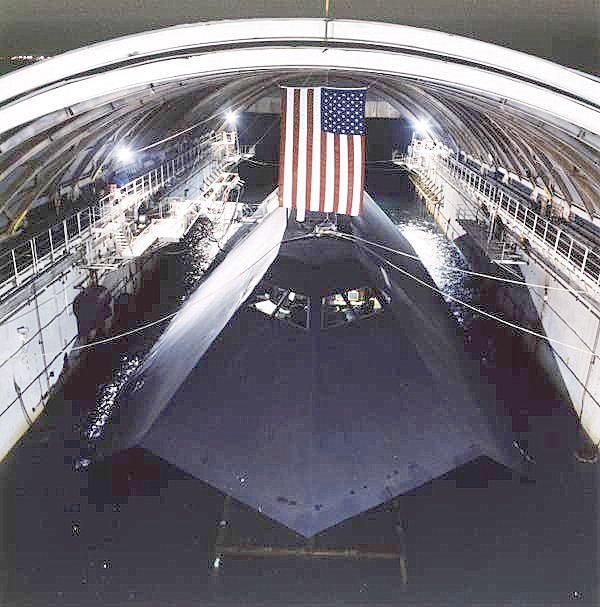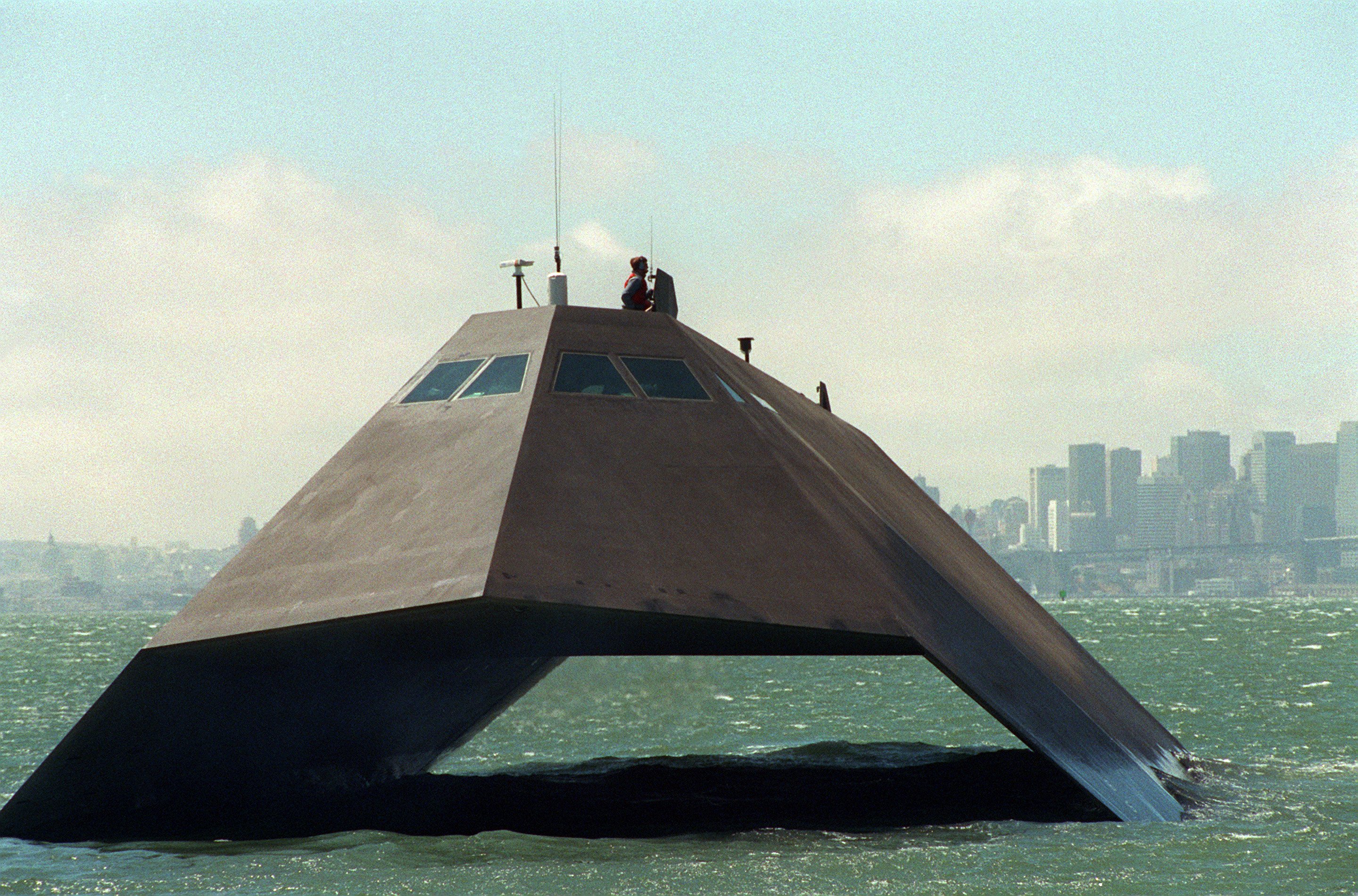Sea Shadow
The Sea Shadow was built as a test platform for several ship technologies, among them ship control, automation, structures, sea-keeping, and stealthy all signature reduction. The program was sponsored by the US Navy, DARPA, and Lockheed Martin. Results of the signature reduction research have been used in the faceted stealth design of the Arleigh Burke (DDG-51) class, Zumwalt (DDG-1000) class destroyers, and SWATH configuration in the ocean surveillance ships (T-AGOS 19-23) used to conduct Surveillance Towed Array Sensory System (SURTASS) operations. It was not intended as a prototype stealth warship, but a technology demonstrator.
In designing a ship with reduced radar signature, the main concerns are radar beams originating near or slightly above the horizon (as seen from the ship) coming from distant patrol aircraft, other ships or sea-skimming anti-ship missiles with active radar seekers. Therefore, the shape of the ship avoids vertical surfaces, which would perfectly reflect any such beams directly back to the emitter. Retro-reflective right angles are eliminated to avoid causing the cat's eye effect. A stealthy ship shape can be achieved by constructing the hull and superstructure with a series of slightly protruding and retruding surfaces. This design was developed by several German shipyards, and is thus extensively applied on ships of the German Navy.
Sea Shadow was designed and built in 1984 by the Lockheed “Skunk Works”, home of stealthy aircraft such as the SR-71 Blackbird, and F-117A Nighthawk fighter. Construction began in 1983 inside the floating dock Hughes Mining Barge (HMB-1). Cost was estimated at $195M including construction at $50M. The ship was a small waterplane area twin hull (SWATH) configuration with two submerge hulls containing diesel electric propulsion.
Utilization of the Sea Shadow
In the Fall of 1994 it served for the first time as a test platform for advanced Combat Systems prototypes. These prototypes were adapted to the Sea Shadow's test profile. The prototypes were designed to be driven by active radar, passive sensors, and Tactical Data Link 11 and 16. The test profile dictated operating in a receive-only mode for track information from Link 11, relying on off-board sensors only. The reference data, including maps and commercial airways, was loaded into the prototypes to cover testing along the Southern California coast.
The two Combat System prototypes were the Automated Combat Identification System (ACIDS) and the Tactical Action Advisor (TAA). ACIDS is designed as a decision aid to automatically identify air and surface tracks based on sensor and intelligence information as defined by the tactical operators. The TAA system is a decision aid that supports a Tactical Action Officer or Warfare Commander in determining threats to ownship based on ownship signatures, threat sensors and threat weapons. Systems such as ACIDS and TAA are of value to various platforms, but are particularly important when mission requirements dictate no operation of active sensors. The testing and demonstration of the ACIDS and TAA prototypes on the Sea Shadow was funded by ARPA as part of the High Performance Distributed Experiment (HiPer-D) program.
Following conclusion of testing, the Sea Shadow and Hughes Mining Barge were moved to San Diego and docked at the 32nd Street pier. By late 1994 Sea Shadow was maintained in a lay-up status and homeported at Naval Station San Diego.
 |
| Sea Shadow(IX-529) moored in the Hughes Mining Barge (HMB-1) |
| Career (U.S.) | |
|---|---|
| Name: | Sea Shadow |
| Awarded: | 22 October 1982 |
| Builder: | Lockheed |
| Completed: | 1984 |
| Acquired: | 1 March 1985 |
| Out of service: | September 2006 |
| Struck: | September 2006 |
| Fate: | Scrapped in 2012 |
| General characteristics | |
| Type: | Stealth ship |
| Displacement: | 563 long tons (572 t) |
| Length: | 164 ft (50 m) |
| Beam: | 68 ft (21 m) |
| Draft: | 15 ft (4.6 m) |
| Propulsion: | Diesel-electric |
| Speed: | 14.2 knots (26.3 km/h; 16.3 mph) |
| Complement: | 4 |
| Armament: | None |
Roots of the DDG-1000 USS Zumwalt
In anticipation of conducting future ship research and development testing, the U.S. Navy reactivated the Sea Shadow craft in early 1999. Engineers from Lockheed Martin Technical Services-San Diego managed repairs performed by the National Steel and Shipbuilding Company to make the craft seaworthy as well as to repair the vessel's full-enclosure dry dock. Following reactivation, the crew sailed Sea Shadow from San Diego to the former Alameda Naval Air Station in Oakland, CA.
Sea Shadow supported risk reduction for future surface ship platforms such as DD 21 [leading to the DDG-1000 USS Zumwalt class], the Navy's 21st Century Land Attack Destroyer. The platform allowed the Navy to explore and test, in a realistic at-sea environment, important DD 21 advanced information and automation technologies that support reduced manning and ship survivability.
Espionage
John Douglas Charlton, a retired Lockheed Corporation engineer, was arrested on 25 May 1995 for attempting to sell secret documents removed from the company at the time of his retirement. According to an Assistant US Attorney, the plans concerned the Sea Shadow, a Navy stealth project and the Captor Project related to mines which release anti-submarine torpedoes. According to the 10-point espionage indictment, Charlton tried to sell the information to an FBI agent posing as a foreign government representative.
Following a plea agreement on 17 October, Charlton pleaded guilty to selling two classified schematic drawings related to the antisubmarine program. He admitted knowing that the Captor Project information that the former engineer attempted to sell to what he believed to be a French official was highly classified. According to the prosecuting attorney, "The documents would have enabled any nation to discover some of the workings of the program." On 8 April 1996, Charlton was sentenced to two years in Federal prison and fined $50,000 for his guilty plea to two counts of attempted transfer of defense information. He will be placed on five years’ probation after his release. He is not eligible for parole.
- Los Angeles Times 26 May 1995, "Ex-Aerospace Worker Indicted In Spy Case"
- Antelope Valley Press 18 Oct 1995, "Valley Man Pleads Guilty To Attempted Espionage"
- Los Angeles Times 10 Apr 1996, "Retired Engineer Gets 2 Years in Defense Espionage Case"
Espionage Cases May 2009.pdf
End of the ship
What became of the IX-529 Sea Shadow? - The Scrapping of the Ix-529 @ Mulli Photo.Unclassified Miscellaneous (IX) Ship Photo Index
World News — The United States Navy IX-529 sea shadow stealth...
us navy sea shadow


No comments:
Post a Comment